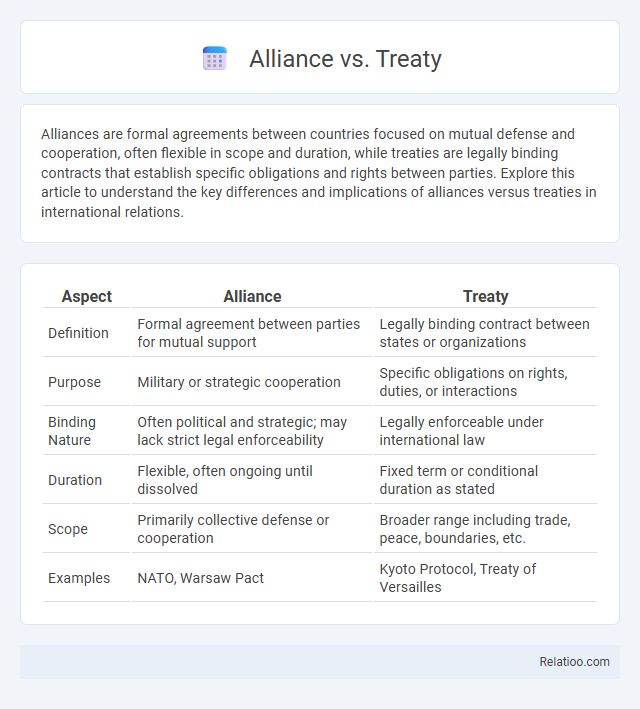Alliances are formal agreements between countries focused on mutual defense and cooperation, often flexible in scope and duration, while treaties are legally binding contracts that establish specific obligations and rights between parties. Explore this article to understand the key differences and implications of alliances versus treaties in international relations.
Table of Comparison
| Aspect | Alliance | Treaty |
|---|---|---|
| Definition | Formal agreement between parties for mutual support | Legally binding contract between states or organizations |
| Purpose | Military or strategic cooperation | Specific obligations on rights, duties, or interactions |
| Binding Nature | Often political and strategic; may lack strict legal enforceability | Legally enforceable under international law |
| Duration | Flexible, often ongoing until dissolved | Fixed term or conditional duration as stated |
| Scope | Primarily collective defense or cooperation | Broader range including trade, peace, boundaries, etc. |
| Examples | NATO, Warsaw Pact | Kyoto Protocol, Treaty of Versailles |
Understanding Alliances and Treaties
Understanding alliances and treaties involves recognizing that alliances are formal agreements between nations to cooperate for mutual benefit, often including defense commitments, while treaties are legally binding documents that outline specific terms and obligations between parties. Your knowledge of alliances highlights their strategic purpose in fostering long-term partnerships, whereas treaties serve as the legal foundation that codifies these agreements. Distinguishing between these concepts is crucial for grasping how countries collaborate diplomatically and maintain international order.
Key Differences Between Alliances and Treaties
Alliances and treaties both establish formal agreements between entities, but they differ primarily in scope and intent. An alliance often implies a strategic partnership focused on mutual defense or shared interests, while treaties encompass a broader range of legal commitments, including trade, peace, and territorial agreements. Understanding these key differences helps you better navigate international relations and the obligations your country might undertake.
Historical Examples of Alliances
Historical examples of alliances, such as the Triple Alliance between Germany, Austria-Hungary, and Italy in World War I, demonstrate how nations form strategic partnerships to enhance mutual defense and political influence. Unlike treaties, which are formal agreements often focused on specific terms like peace or trade, alliances typically encompass broader military and diplomatic commitments over time. Understanding these distinctions helps you analyze the complex dynamics of international relations and predict the outcomes of multinational cooperation.
Notable Treaties Throughout History
Notable treaties throughout history have shaped international relations, such as the Treaty of Westphalia (1648), which established the principles of state sovereignty and non-intervention. The Treaty of Versailles (1919) ended World War I but imposed harsh penalties on Germany, influencing geopolitical dynamics and leading to World War II. Alliance agreements, like NATO formed in 1949, demonstrate collective defense commitments, while treaties like the Kyoto Protocol (1997) focus on global environmental cooperation.
Objectives and Purposes of Alliances
Alliances are formal agreements between entities, primarily focused on mutual defense, economic cooperation, or strategic goals, differing from treaties which are broader legal contracts with diverse objectives including peace, trade, or territorial issues. The core purpose of alliances is to create a cohesive and cooperative relationship that strengthens the collective capabilities and security of the members involved. Your understanding of alliances should emphasize their role in aligning military, political, or economic interests to achieve shared objectives effectively.
Legal Frameworks Governing Treaties
Treaties are formal agreements governed by international law, specifically outlined in the Vienna Convention on the Law of Treaties, which establishes clear rules for their creation, implementation, and enforcement. Alliances, often a subset of treaties, specifically involve mutual defense commitments between states, governed by both general treaty law and specific military cooperation agreements. Understanding your legal framework ensures clarity on obligations, dispute resolution, and termination procedures within these international legal instruments.
Formation Processes: Alliance vs Treaty
The formation process of an alliance involves mutual agreement and shared goals between parties, often emphasizing long-term cooperation and defense commitments. Treaties are formal, legally binding agreements ratified by governments or authorized authorities, requiring detailed negotiation and adherence to international law. Your choice between an alliance and a treaty depends on the desired level of formalization and legal obligation in international or organizational partnerships.
Strengths and Weaknesses of Each Agreement
Treaties establish formal, legally binding commitments between parties, ensuring clear obligations but often lacking flexibility to adapt quickly to changing circumstances. Alliances foster cooperative defense and mutual support, enhancing collective security, though they may be strained by differing national interests or unequal commitment levels. Partnership agreements emphasize collaboration without strict obligations, providing adaptability but potentially weakening enforcement and reliability in critical moments for your strategic objectives.
Impact on International Relations
Treaties formalize agreements between states, creating binding legal obligations that shape diplomatic behavior and foster predictability in international relations. Alliances, often military in nature, establish collective defense commitments that can deter aggression and shift power balances among nations. Unlike alliances, broader coalitions or partnerships may focus on shared interests without formal obligations, influencing cooperation dynamics but with less enforceable impact on global stability.
Future Trends: Alliances and Treaties in Modern Diplomacy
Future trends in modern diplomacy reveal a shift towards more flexible alliances that emphasize issue-specific cooperation rather than broad, binding treaties. Digital diplomacy and multilateral frameworks are increasingly shaping alliance formations, promoting adaptive responses to global challenges like cybersecurity and climate change. Treaties are evolving through modular agreements that allow states to incrementally deepen commitments without fully rigid structures, enhancing diplomatic agility.

Infographic: Alliance vs Treaty
 relatioo.com
relatioo.com